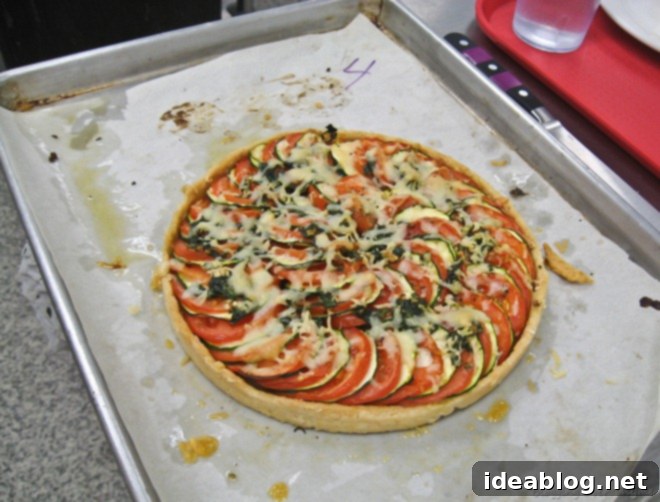Culinary School Adventure: Mastering Ambitious Dishes – Zucchini & Tomato Tart, Seared Duck Breast, and Raspberry Roulade
After a bustling open house on Saturday, the past weekend seemed to vanish in a blink, and arriving at school this morning felt as though I had never truly left! This sense of continuity, however, proved to be rather beneficial, as today’s culinary agenda was exceptionally ambitious. To be truly candid, when I say ambitious, I genuinely mean it was an utterly crazy schedule packed with complex preparations. Here’s a detailed look at the demanding and incredibly rewarding menu we tackled:
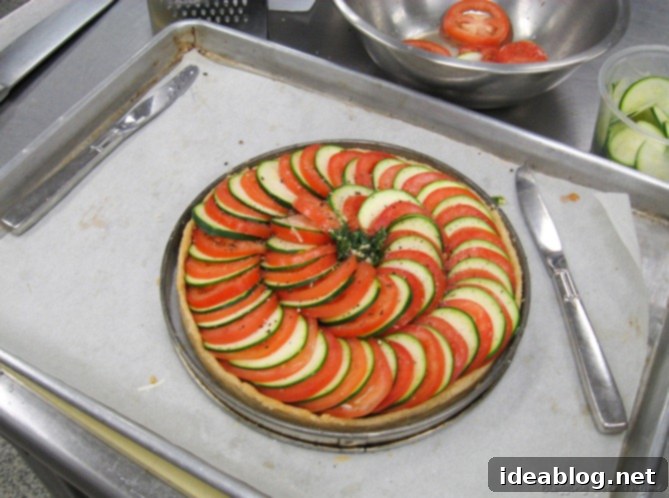
Crafting the Elegant Zucchini & Tomato Tart: A Fresh Appetizer
Our opening course for the day was a vibrant Zucchini & Tomato Tart. This dish immediately sparked my excitement, not just for its beauty but also because it’s slated to appear on a future culinary exam. Despite its sophisticated appearance, this tart is surprisingly straightforward to assemble. The key lies in its filling, where all the primary ingredients—zucchini, tomatoes, basil, and garlic—are used raw, preserving their fresh flavors and vibrant textures. However, the simplicity of the filling doesn’t negate the foundational work required. We had to meticulously prepare pate brisee dough entirely by hand, ensuring it was perfectly chilled to achieve the ideal flaky texture, and then perform a crucial blind bake to create a crisp shell before adding the delicate raw ingredients. This hands-on process, from mixing the flour and butter to chilling and rolling, taught me invaluable lessons in pastry technique and patience.
I am definitely planning a dedicated recipe post for this tart in the near future because it has quickly become one of my favorite creations we’ve made at school so far. It embodies my ideal kind of food: fresh, light, and bursting with natural flavors. The combination of garden-fresh vegetables and aromatic herbs creates an exquisite balance. Not to mention, it tasted incredibly fresh and light, making it the perfect starter. I can only imagine how utterly delicious this tart must be during the peak summer months when local tomatoes are at their most flavorful and abundant, truly elevating the dish to another level of culinary delight.
The tart is artfully assembled with thinly sliced basil, minced garlic, crisp zucchini, and juicy tomatoes, arranged in a visually appealing pattern. It’s then lightly topped with a modest amount of nutty Gruyère and savory Parmesan cheese, which melt into a golden crust during baking. I almost hesitated to add any cheese at all, as the natural beauty of the vegetables, once arranged, was so stunning on its own! The minimalist approach really allows the quality of the ingredients to shine through. The final product, as it emerged from the oven, was a masterpiece of color and texture, promising a delightful culinary experience:
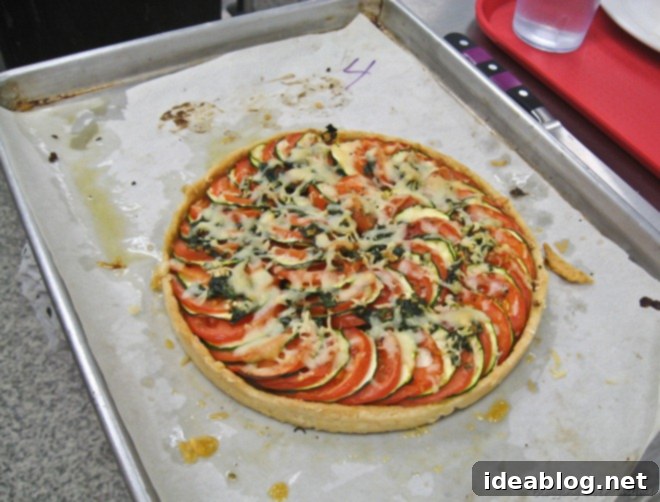
An Epic Main Course: Mushroom Risotto & Seared Duck Breast with Orange Gastrique
Our main course presented an even greater challenge, essentially requiring us to produce two distinct, yet equally intricate, main dishes: a creamy Mushroom Risotto and an exquisite Seared Duck Breast with Orange Gastrique Sauce. Having prepared risotto at home a few times, I felt a reasonable degree of confidence regarding this particular dish. However, the method employed at school was slightly different and notably more complex than my home versions. For our risotto, we utilized four different types of mushrooms, each requiring individual sautéing beforehand to extract and deepen their distinct flavors before they were incorporated into the creamy Arborio rice. This layering of mushroom flavors added an incredible depth and umami to the final dish.
Today also marked a significant milestone: our inaugural experience cooking with duck! I’m fairly certain this entire period could be accurately dubbed “Duck Week” in our curriculum, given the extensive work we undertook with this ingredient. To prepare our perfectly seared duck breasts and their accompanying gastrique sauce, each student was tasked with breaking down a whole duck. This process proved to be discernibly trickier and more involved than butchering a chicken, demanding precision and a keen understanding of avian anatomy. We then meticulously collected the spine, back, and neck bones (after carefully chopping them) to create a rich jus. This involved searing the bones over high heat, deglazing the pan with a mirepoix of aromatic vegetables, and then adding veal stock. This foundational jus was left to simmer gently, concentrating its flavors, until we were ready to embark on the creation of our gastrique sauce.
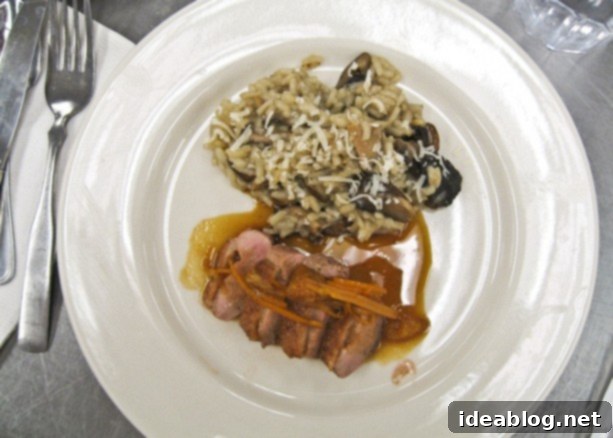
A gastrique is a revered classic in French cuisine, fundamentally a vinegar-based sauce often brilliantly paired with rich, fatty meats such as duck. The inherent acidity of the vinegar serves a dual purpose: it not only masterfully cuts through the richness of the fat, balancing the flavor profile, but traditionally, it was also believed to aid in digestion. The intricate process of making a gastrique begins with the delicate art of crafting a perfect caramel from sugar and water. Once the caramel reaches its desired hue and consistency, an acid is introduced—in our case, fine sherry wine vinegar—to stop the cooking process and create the tangy base. Once this fundamental gastrique was meticulously prepared, we combined it with our carefully strained duck jus, allowing their flavors to meld harmoniously. Because we were specifically creating an orange gastrique, we further enhanced it with fresh orange juice and finely julienned orange peel. The orange peel required an extra step: it had to be blanched not just once, but three times to remove any bitterness and soften its texture, ensuring a clean, vibrant orange flavor. The sauce was eventually garnished with elegant orange segments, adding a final touch of freshness and visual appeal.
The resulting orange gastrique sauce boasts a complex flavor profile: a subtle bitter note from the orange zest, a pleasant sweetness from the caramel, and a bright, cutting acidity from the vinegar. While tasted on its own, I wasn’t a huge fan of its intense characteristics, I was genuinely surprised by how exceptionally well it paired with the succulent seared duck breast. The interplay of flavors was truly remarkable, a testament to the classic pairing’s brilliance.
As for the duck itself… achieving that perfectly crispy skin and tender, juicy meat is a specific technique. The duck breasts were initially placed skin-side down in a sauté pan and cooked over very low-medium heat. This precise temperature control is absolutely key, as it allows the fat to render slowly and thoroughly, resulting in incredibly crispy skin. If the heat is too high, the fat gets trapped beneath the skin, preventing it from crisping up at all! Once the skin was golden brown and perfectly rendered, we quickly seared the other side of the breast for a short duration, ensuring the interior remained beautifully pink and tender. After searing, the duck was allowed to rest, a crucial step that re-distributes the juices, before being thinly sliced and plated.
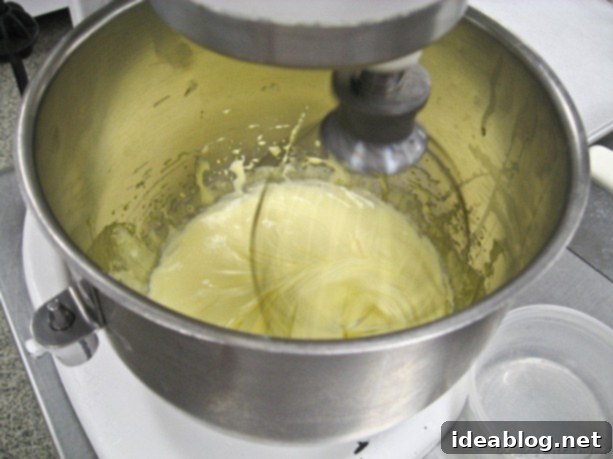
The Sweet Finale: Mastering the Raspberry Roulade Cake
And last, but certainly not least, to round off our incredibly demanding day, each of us was responsible for independently making a beautiful roll cake. See what I mean by there being an immense amount to accomplish in a single day?! This dessert truly pushed our pastry skills to the limit.
Our delicate sponge roll cake, famously known as a ROULADE, is another foundational technique that will undoubtedly make a prominent appearance on a future culinary exam. Consequently, I devoted extra attention to every step, striving for perfection and ensuring I executed each part of the process flawlessly. This particular dessert also holds a special place in my heart, as my mom used to bake us delicious sponge roll cakes for our birthdays and other special occasions all the time! I absolutely adore them. While this recipe was slightly different from my mother’s cherished version, it was nonetheless quite exquisite. To simplify the initial learning curve and allow us to practice our crucial rolling technique, our roulades were simply brushed with a light simple syrup and generously filled with sweet raspberry preserves. This basic iteration provides an excellent foundation; eventually, we will advance to filling them with luxurious buttercreams, airy whipped creams, and an array of other delightful fillings, exploring the endless possibilities of this versatile dessert.
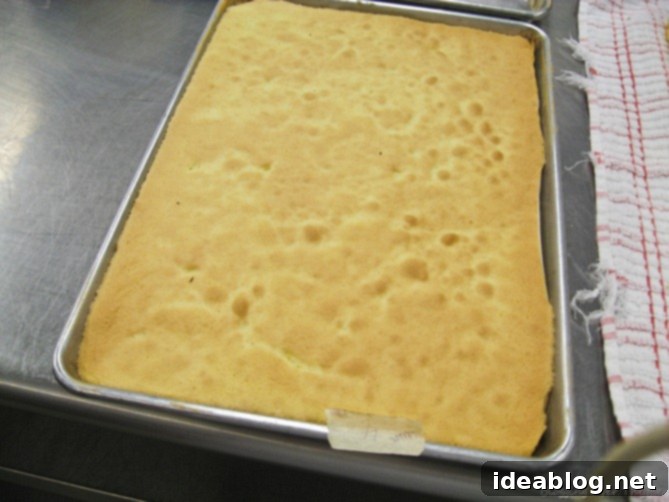
The creation of a perfect Roulade Cake begins with whisking together egg yolks and sugar. This mixture is often gently warmed over a bain-marie (a water bath) to help dissolve the sugar and achieve a pale, thick consistency known as the “ribbon stage,” where the mixture forms a ribbon when lifted. In a separate, impeccably clean bowl, we prepared a light and airy French soft meringue by gradually beating egg whites to stiff peaks while slowly incorporating granulated sugar, ensuring a stable and voluminous foam. At this critical juncture, the delicate egg white mixture is slowly and carefully folded into the richer egg yolk mixture. This step demands a gentle hand to maintain the airiness of both components. To this combined base, well-sifted cake flour is gradually folded in, followed by a very small amount of melted (and often clarified) butter. This folding process must be executed with utmost care and precision to avoid deflating the incorporated air, which is vital for the sponge’s light and tender texture.
After baking for a mere 5-7 minutes, the transformation into a perfectly baked sponge cake is complete! The paramount trick to a successful roulade is not to overbake it, because a dry sponge will become utterly impossible to roll without cracking. Our freshly baked roll cakes were carefully inverted onto a clean kitchen towel, lightly brushed with simple syrup to keep them moist and pliable, and then evenly spread with a very thin layer of thick, vibrant raspberry preserve. Then came the moment of truth: the rolling! This step requires a steady hand and confidence, using the towel to gently guide the cake into its characteristic spiral shape. The process, while challenging, was incredibly satisfying once achieved.
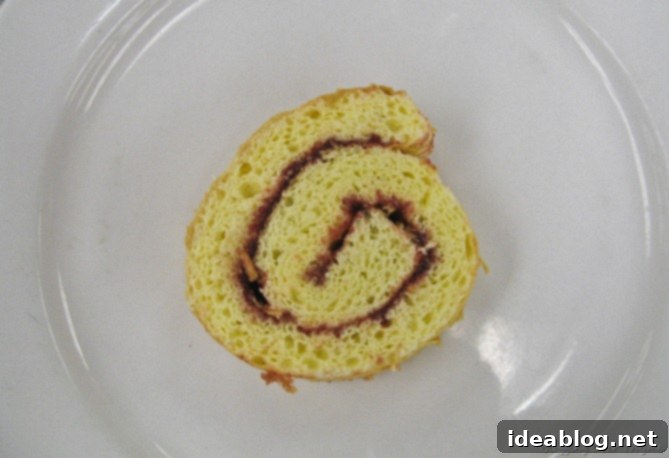
Despite its somewhat humble appearance in its initial, practice form, the cake was significantly tastier than it appears! The delicate crumb and the burst of fresh raspberry made for a delightful combination. I am particularly captivated by the incredible versatility of a sponge cake; the creative possibilities for fillings and decorations are truly endless. I’m eagerly looking forward to experimenting and making many more variations at home in the future, perfecting this classic pastry technique.
Wrapping Up a Monumental Day and Looking Ahead
Somehow, despite the sheer volume and complexity of the dishes—seven fully plated servings of everything, from appetizer to dessert, for evaluation—we miraculously managed to serve all of this and get it impeccably plated by around 12:30 PM. This was technically considered late by our rigorous culinary school standards, but given the scope of work, it felt like a triumph.
The afternoon session transitioned from hands-on cooking to an insightful, albeit quick, lecture on the traditional preparation of duck confit, a topic I am keen to delve into more deeply in a future post! This classic French preservation method essentially involves curing duck legs in salt and herbs, and then slowly cooking them submerged in their own rendered duck fat. Today, we even began the preliminary step of rendering the duck fat itself, which involved grinding massive quantities of duck fat in the substantial meat grinder (as seen below). It was an undeniably interesting, and I must admit, a slightly visceral and somewhat disgusting process to witness and participate in, but absolutely essential for authentic confit.
As Chef Brian sagely reminds us, a principle we’ve truly embraced in “Duck Week”: “No duck fat left behind!” This motto underscores the chef’s commitment to minimizing waste and maximizing flavor, utilizing every part of the valuable ingredient.
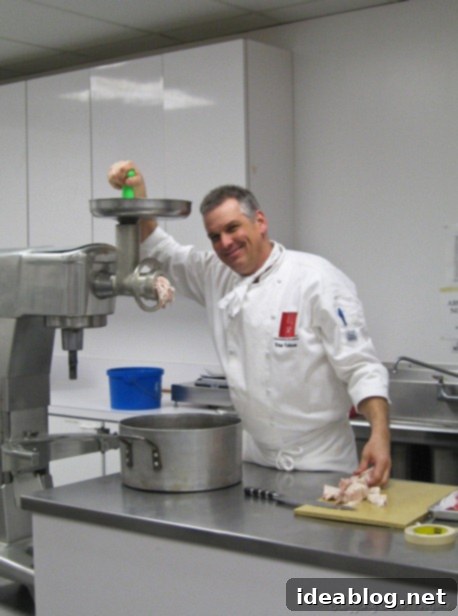
On that rather intense and educational note, I am now off to immerse myself in studying for my second practical and theory test, which is fast approaching this coming Thursday! The pressure is on, but the knowledge and skills gained from ambitious days like these are truly invaluable.
